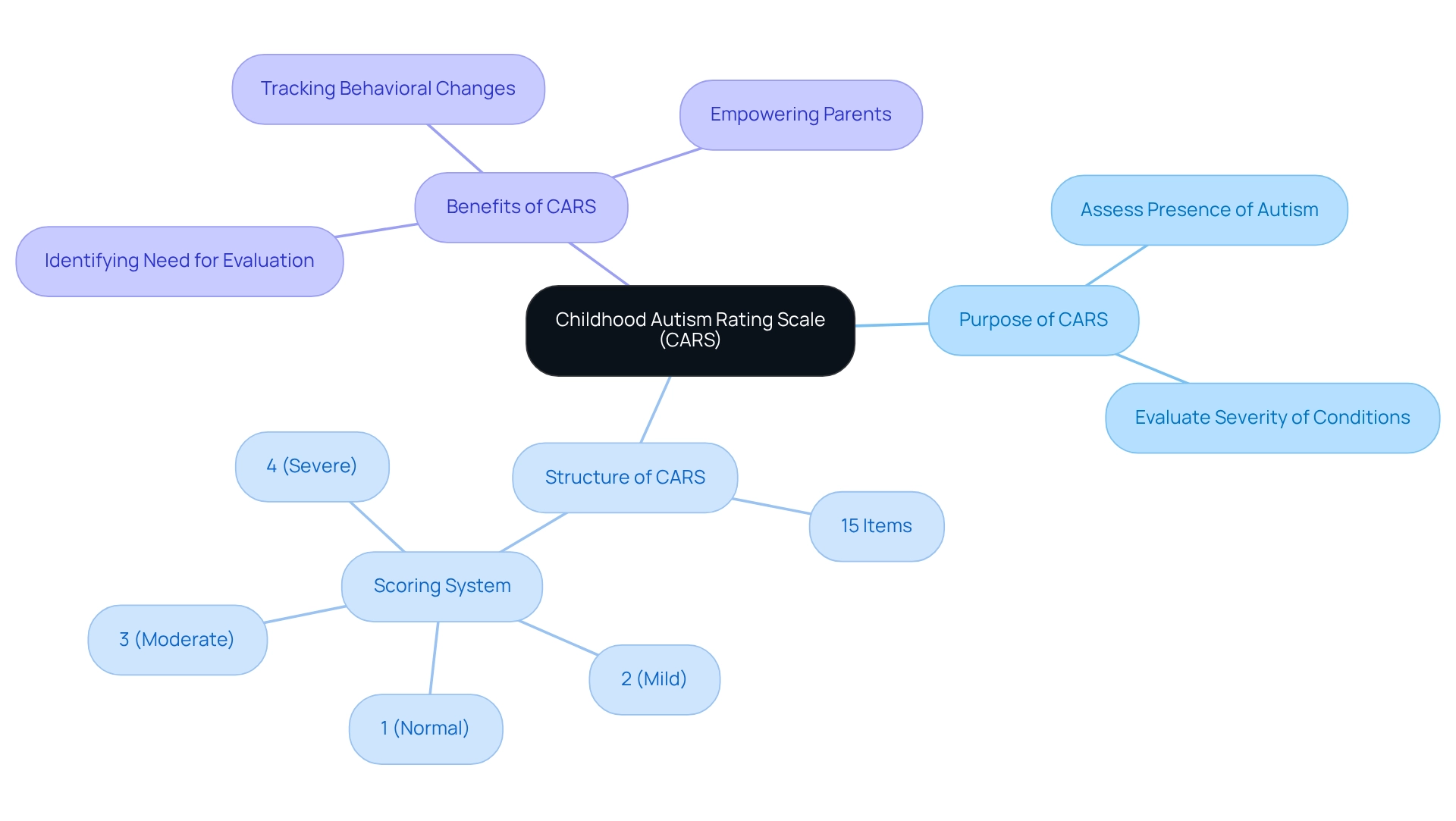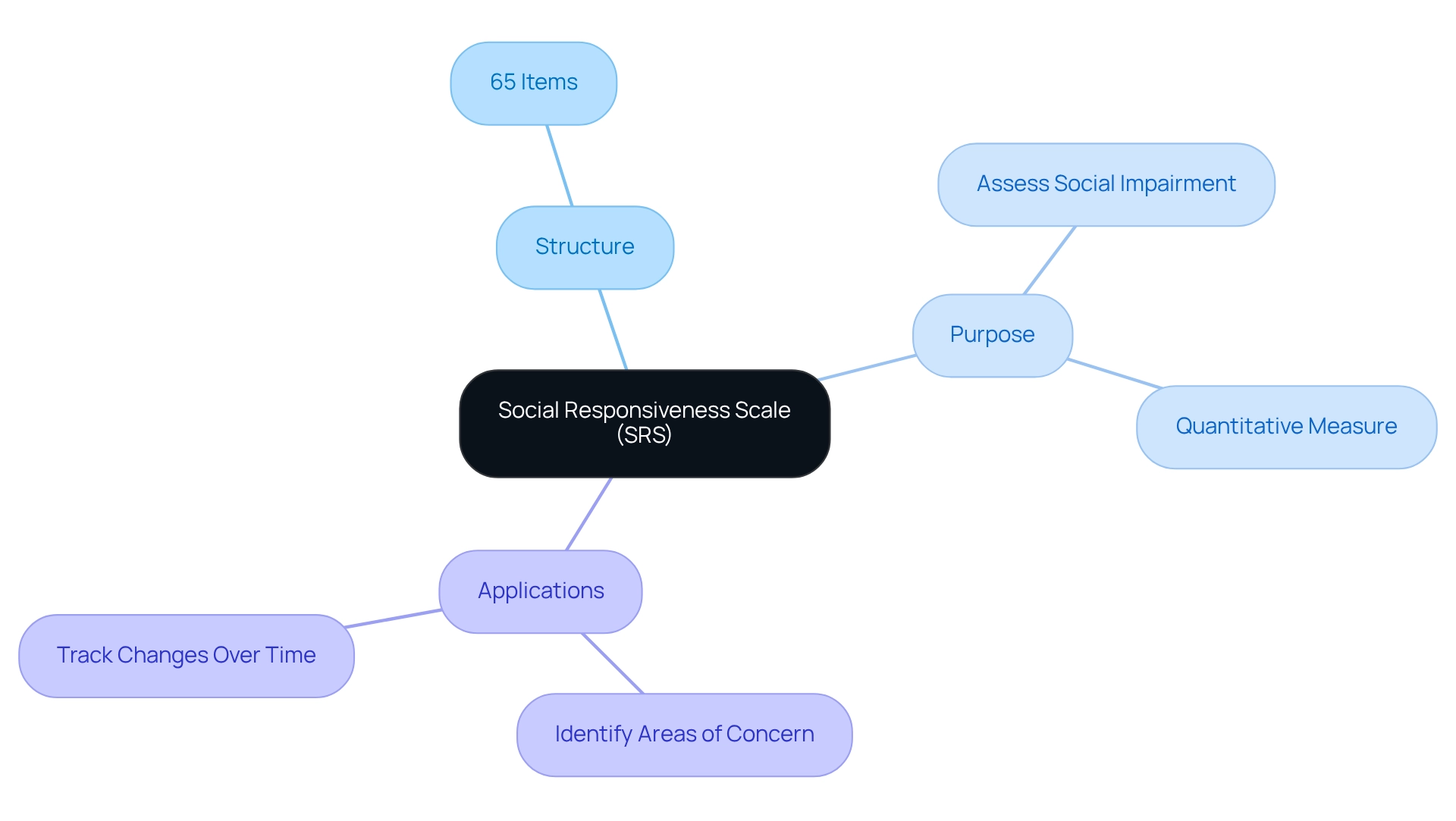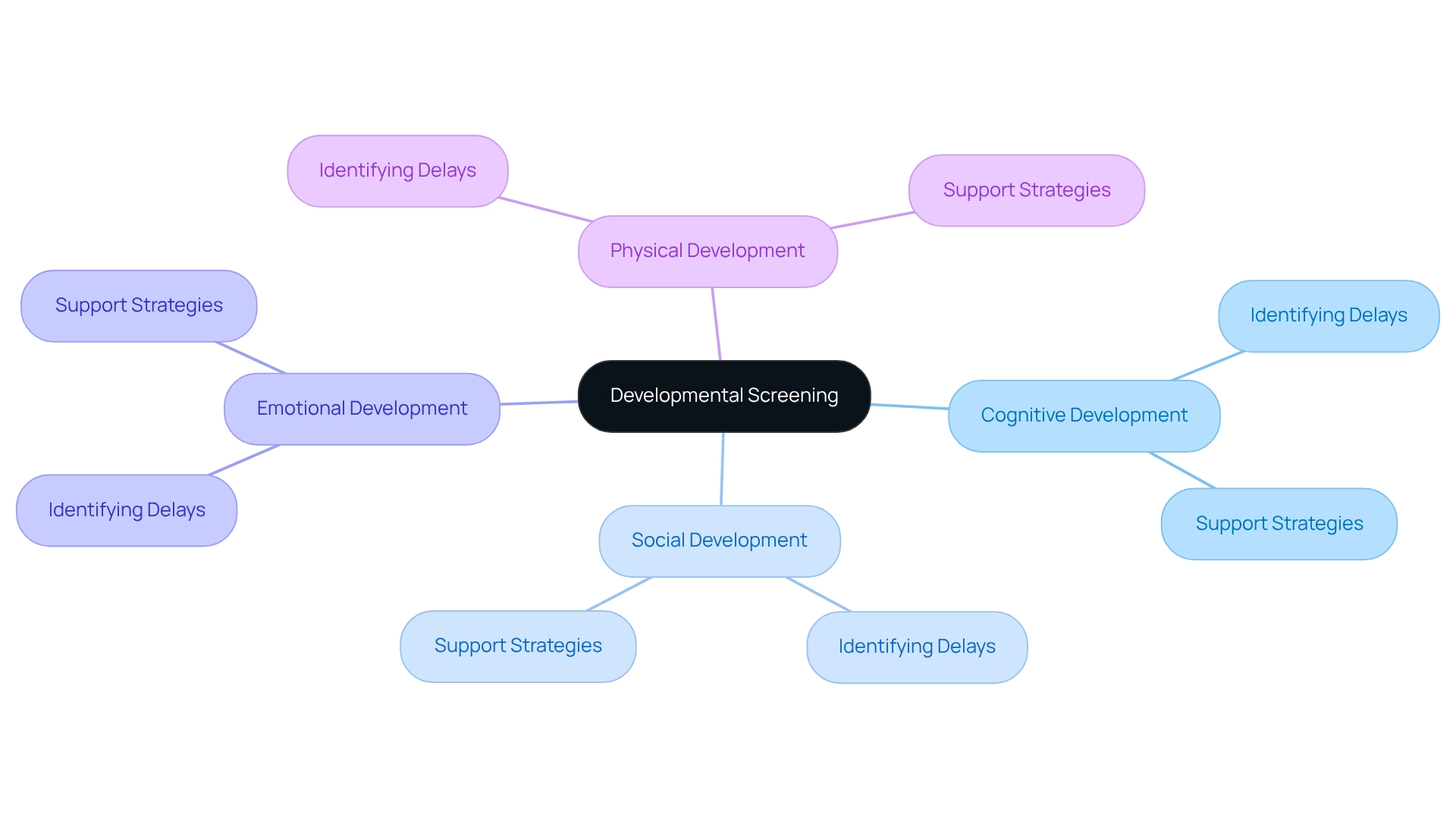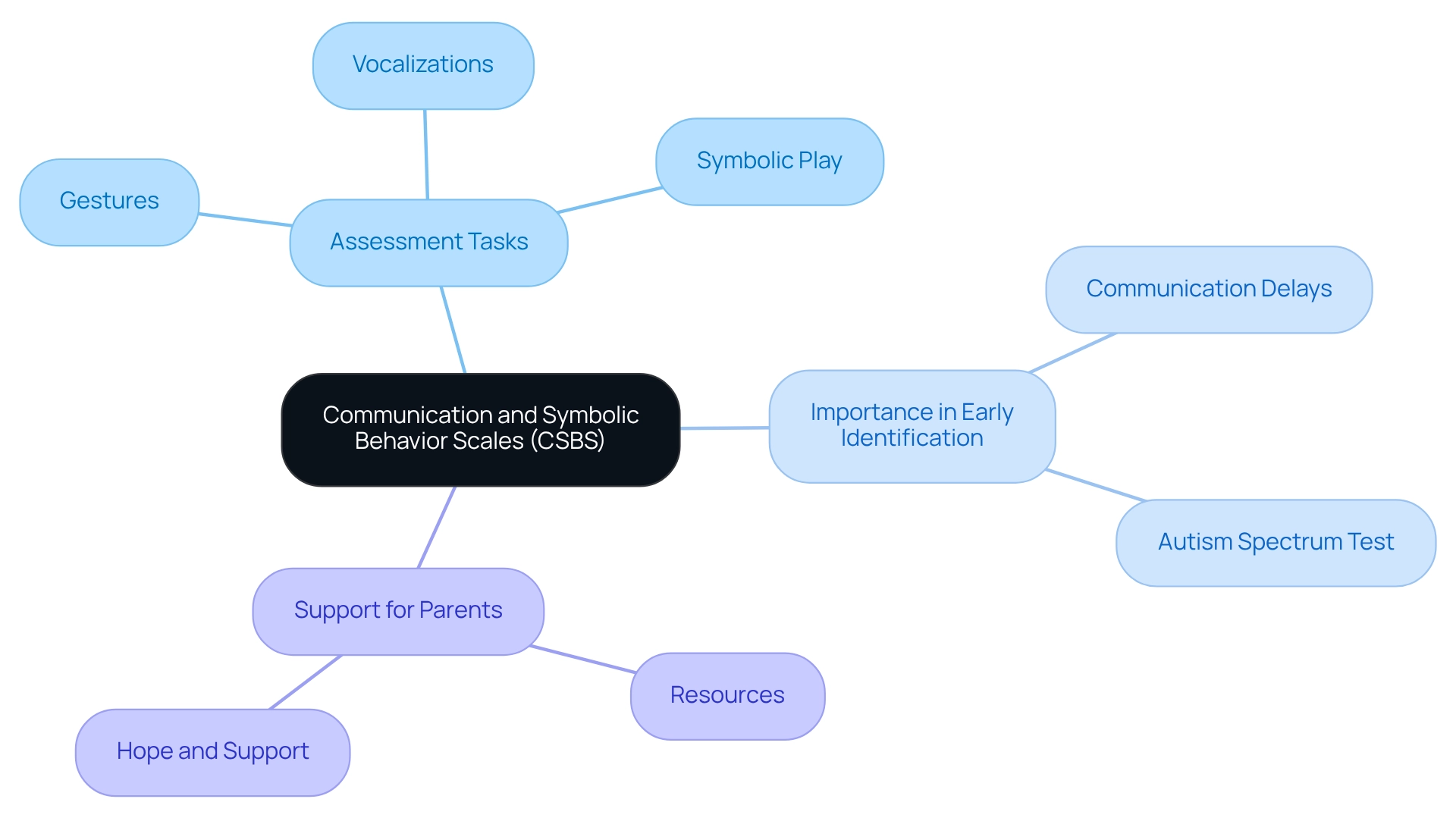Overview
When it comes to understanding your toddler's development, essential autism spectrum tests like the M-CHAT, ASQ, and CARS play a crucial role. These tools are designed to identify developmental delays and autism-related behaviors early on, providing parents with valuable insights. Recognizing the importance of these screening tools can be a game-changer, as early detection significantly improves developmental outcomes for children at risk for autism spectrum disorders.
As a parent, you may feel overwhelmed by the thought of your child's development. It's important to remember that you're not alone in this journey. Many parents share similar concerns, and seeking out these tests can lead to timely interventions that make a difference. By understanding the signs and accessing these resources, you can take proactive steps towards supporting your child's growth.
We encourage you to explore these screening tools and consider discussing them with your pediatrician. Taking action now can pave the way for a brighter future for your child, filled with opportunities for growth and success. Remember, early intervention is key, and every step you take can help your little one thrive.
Introduction
In the world of early childhood development, the significance of timely and effective screening tools truly cannot be overstated. These assessments act as essential instruments for identifying potential developmental delays and autism spectrum disorders in young children. By facilitating early intervention, they can profoundly influence a child’s growth and learning journey.
From the Modified Checklist for Autism in Toddlers (M-CHAT) to the Sensory Profile, each tool provides unique insights into a child's behavior and development. This article will explore a variety of crucial screening tools, detailing their methodologies, applications, and the vital role they play in nurturing optimal developmental outcomes for children.
For both parents and healthcare providers, understanding these assessments is key to navigating the complexities of child development and ensuring that every child has the opportunity to flourish.
M-CHAT: Modified Checklist for Autism in Toddlers
The M-CHAT (Modified Checklist for Autism in Toddlers) is a vital tool for parents concerned about their child's development. Designed specifically for toddlers aged 16 to 30 months, this autism spectrum test serves as a parent-report screening instrument. It comprises 20 simple yes/no questions that examine behaviors associated with autism, allowing parents to reflect on their child's behaviors during routine pediatric visits.
As parents complete the checklist, the results can reveal whether further evaluation is necessary. This screening is particularly effective in identifying children who may benefit from additional diagnostic assessments. Early identification is crucial, as it opens the door to intervention strategies that can significantly enhance developmental outcomes.
For those seeking more information and support, visit Autism Speaks. Your child's journey is important, and understanding these tools can empower you to make informed decisions.
ASQ: Ages and Stages Questionnaires
The Ages and Stages Questionnaires (ASQ) is an invaluable resource for parents and caregivers, designed to assess the development of young children. This tool consists of a series of parent-completed questionnaires that evaluate five essential areas:
- communication
- gross motor skills
- fine motor skills
- problem-solving
- personal-social skills
Aimed at children aged 1 month to 5 years, the ASQ is crucial for identifying any developmental delays that may need further attention.
Implementing the ASQ regularly during pediatric visits is highly recommended. It not only helps track a child's developmental progress but also ensures timely referrals for additional support when necessary. Research shows that early screening, whether during enrollment or at planned parent meetings, significantly increases the chances of successful interventions. For instance, a case study from Healthy Families Niagara demonstrated that the ASQ effectively identifies developmental delays, allowing children to catch up on milestones before starting kindergarten. This ensures they receive the foundational support critical for their educational journey.
Moreover, the effectiveness of the ASQ is supported by development specialists who advocate for its use in pediatric practices. Current statistics reveal that more pediatricians are incorporating the ASQ into their evaluations, recognizing its benefits in monitoring development and identifying potential delays early on. In fact, recent studies indicate that approximately 1 in 5 toddlers may experience developmental delays, highlighting the importance of tools like the ASQ for early identification.
Additionally, Open Education Resources (OER) are available to assist parents and professionals in understanding and implementing the ASQ effectively. By leveraging the ASQ, parents and professionals can collaborate to promote optimal developmental outcomes for children. If you have experiences or thoughts to share about the ASQ, we encourage you to connect with us through comments or our newsletter. Together, we can ensure that every child receives the support they need to thrive.
CARS: Childhood Autism Rating Scale
The Childhood Autism Rating Scale (CARS) serves as a valuable tool for parents and clinicians alike, offering insights into the presence and severity of autism spectrum conditions in toddlers aged 2 years and older. This compassionate assessment comprises 15 items that evaluate various behaviors associated with autism, scored on a scale from 1 (normal) to 4 (severe).
Understanding your child's needs can be challenging, and CARS is particularly beneficial in identifying children who may need further diagnostic evaluation. It also helps track behavioral changes over time, which can be crucial in informing treatment decisions. This resource not only aids in understanding your child better but also empowers you to take informed steps forward.
For more details and support, we encourage you to visit WPS. Your journey as a parent is important, and having the right tools can make all the difference.

ADOS: Autism Diagnostic Observation Schedule
[The Autism Diagnostic Observation Schedule (ADOS) is a semi-structured assessment designed to evaluate communication, social interaction, and play in individuals who may have a developmental disorder. This tool is created for individuals of all ages and is particularly effective in diagnosing spectrum disorders related to behavior, including autism spectrum tests for toddlers. By directly observing individuals during various activities, clinicians can assess behaviors that may indicate autism. This assessment is often used alongside autism spectrum tests for toddlers and other evaluations, providing a comprehensive insight into a young person's developmental profile.
As a parent, understanding the assessment process can be daunting. It’s essential to know that the ADOS is a supportive tool, aimed at helping you and your child navigate the complexities of developmental challenges. For more information, check out WPS to learn more about how this assessment can support your journey.
SRS: Social Responsiveness Scale
The Social Responsiveness Scale (SRS) is a valuable tool designed to help assess social impairment in children and adolescents. If you're a parent or teacher, you might be interested to know that the autism spectrum test for toddlers consists of 65 items that you can complete, measuring the severity of social deficits associated with autism spectrum disorders.
This questionnaire provides a quantitative measure of social skills, which is crucial for clinicians conducting autism spectrum tests for toddlers. It helps identify areas of concern and track changes over time. Understanding your child's social functioning can be a journey, and the SRS is particularly useful for monitoring the effectiveness of interventions aimed at enhancing these skills.
If you want to learn more about how the SRS can support your child's development, visit WPS. You are not alone in this; many families are navigating similar paths, and resources like the SRS can make a significant difference.

QCHAT: Quantitative Checklist for Autism in Toddlers
The Quantitative Checklist for Autism in Toddlers (QCHAT) is a compassionate tool designed specifically for parents of toddlers aged 18 to 30 months. This autism spectrum test consists of 25 carefully crafted items that assess various behaviors associated with autism, providing a quantitative measure of autistic traits. Recognizing the signs early can be daunting, but the QCHAT serves as a valuable resource for identifying toddlers who may benefit from further evaluation and intervention.
Understanding your child's development is crucial, and the structured approach of the QCHAT allows for early identification of autism. This early detection can significantly improve long-term outcomes, offering hope and direction for families navigating this journey.
For those seeking more information and support, I encourage you to visit the Autism Research Centre. This resource can provide additional insights and guidance, helping you take the next steps with confidence and care.

Sensory Profile: A Tool for Understanding Sensory Processing
The Sensory Profile serves as a vital evaluation tool designed to assess how young individuals process sensory information in various environments, such as home and school. This evaluation sheds light on their responses to stimuli—like sounds, textures, and lights—helping parents and specialists appreciate their unique sensory traits. Understanding these profiles is essential for developing tailored strategies, including autism spectrum tests for toddlers, which support integration and enhance daily functioning, particularly for children with developmental disorders who often face processing challenges. Notably, updates to the Profile in 2025 reflect ongoing advancements in our understanding of sensory processing. Research shows that the Profile has a positive predictive value (PPV) of about 88% and a negative predictive value (NPV) of 92% when identifying processing challenges linked to autism spectrum tests for toddlers. This impressive accuracy highlights the Profile's effectiveness as a diagnostic tool. As noted by ASD Media, these statistics underscore the Sensory Profile's reliability in guiding interventions.
The practical applications of the Sensory Profile reveal its significant role in shaping effective interventions. For instance, a case study from an online urgent care practice illustrates how personalized care, informed by Sensory Profile results, empowers families to manage their needs with confidence and compassion. By identifying specific processing difficulties, practitioners can implement targeted strategies that greatly improve young individuals' daily experiences, aligning with the goal of enhancing intervention outcomes.
As the field of processing evaluation evolves, the Sensory Profile remains at the forefront, supported by a growing body of interdisciplinary research. Since 2002, approximately 40 researchers have been investigating sensory processing disorder (SPD), contributing to a deeper understanding of how sensory integration strategies can be effectively applied in evaluations for developmental disorders. This collaborative effort emphasizes the importance of utilizing comprehensive evaluation resources like the Sensory Profile to foster better outcomes for youth facing developmental challenges.
Developmental Screening: A Comprehensive Approach
Developmental screening is a vital process that combines various tools and evaluations to assess a young child’s growth in key areas, including cognitive, social, emotional, and physical development. By taking a comprehensive approach, healthcare providers can identify children who may be at risk for developmental delays or disorders. In some cases, this may lead to recommending an autism spectrum test for toddlers. Regular developmental assessments during wellness appointments are essential for ensuring that children receive the support they need to thrive.
As a parent, it’s natural to wonder about your child’s progress. These screenings not only help in identifying potential concerns but also provide peace of mind. Engaging with healthcare professionals during these assessments allows you to address any worries and understand the best ways to support your child’s development.
For more information and resources, please visit CDC. Your child’s growth is important, and accessing the right support can make all the difference.

Communication and Symbolic Behavior Scales (CSBS)
The Communication and Symbolic Behavior Scales (CSBS) is a valuable assessment tool that helps evaluate communication skills in infants and toddlers. It includes a variety of tasks designed to assess how young children use gestures, vocalizations, and symbolic play. Recognizing potential communication delays early on is crucial, and the CSBS plays an essential role in this process. By identifying children who may be at risk, it facilitates timely interventions, such as the autism spectrum test for toddlers.
This tool is particularly beneficial for young ones undergoing the autism spectrum test, as communication challenges are a core aspect of the disorder. Understanding these difficulties can be overwhelming for parents, but resources like the CSBS offer hope and support.
For more details, visit Brookes Publishing. Here, you can find additional information that may guide you in your journey toward supporting your child's communication development.

Parent-Reported Outcomes Measurement Information System (PROMIS)
The Patient-Reported Outcomes Measurement Information System (PROMIS) offers a compassionate approach to understanding health, encompassing physical, mental, and social well-being. For parents of children with autism, the autism spectrum test for toddlers provides valuable insights into their child's functioning and quality of life. By integrating parent-reported outcomes into treatment planning, healthcare providers can tailor interventions to meet each child's unique needs, ultimately enhancing overall outcomes.
This thoughtful approach not only supports children but also empowers parents, guiding them through the complexities of care. By focusing on what truly matters—your child's well-being—we can foster a collaborative environment that prioritizes their health.
Learn more about PROMIS and how it can support your family's journey at HealthMeasures.
Conclusion
Timely and effective screening tools are truly invaluable in the realm of early childhood development, especially for identifying potential developmental delays and autism spectrum disorders. These tools, such as the Modified Checklist for Autism in Toddlers (M-CHAT), Ages and Stages Questionnaires (ASQ), and the Autism Diagnostic Observation Schedule (ADOS), each play distinct yet complementary roles in understanding and nurturing a child's developmental journey.
By utilizing these assessments, parents and healthcare providers can create pathways for early interventions that significantly enhance a child's growth trajectory. The importance of regular screenings and comprehensive assessments cannot be overstated; they offer critical insights that inform treatment decisions and support tailored interventions. For example, tools like the Sensory Profile and Social Responsiveness Scale (SRS) provide valuable perspectives on sensory processing and social skills, which are essential for children with autism.
Ultimately, the significance of understanding and utilizing these screening tools lies in their ability to empower families and professionals alike. By prioritizing early detection and intervention, we can ensure that every child receives the support they need to thrive, paving the way for optimal developmental outcomes. As awareness and understanding of these resources continue to expand, so too does the potential for a brighter future for all children. Let us come together to champion this cause, ensuring that no child is left behind in their developmental journey.
Frequently Asked Questions
What is the M-CHAT and who is it designed for?
The M-CHAT (Modified Checklist for Autism in Toddlers) is a screening tool designed for parents concerned about their child's development, specifically for toddlers aged 16 to 30 months. It consists of 20 yes/no questions that assess behaviors associated with autism.
How does the M-CHAT help parents?
The M-CHAT allows parents to reflect on their child's behaviors during pediatric visits and can indicate whether further evaluation is necessary. Early identification through this tool can lead to intervention strategies that enhance developmental outcomes.
Where can parents find more information about the M-CHAT?
Parents seeking more information and support can visit Autism Speaks at Autism Speaks.
What is the Ages and Stages Questionnaires (ASQ)?
The ASQ is a resource for parents and caregivers to assess the development of young children aged 1 month to 5 years. It consists of questionnaires that evaluate five essential areas: communication, gross motor skills, fine motor skills, problem-solving, and personal-social skills.
Why is the ASQ important for child development?
The ASQ is crucial for identifying developmental delays that may need further attention. Regular implementation during pediatric visits helps track progress and ensures timely referrals for additional support.
How does the ASQ contribute to successful interventions?
Research shows that early screening with the ASQ significantly increases the chances of successful interventions. It allows children to catch up on milestones before starting kindergarten, providing essential support for their educational journey.
What is the Childhood Autism Rating Scale (CARS)?
The CARS is an assessment tool for parents and clinicians that evaluates the presence and severity of autism spectrum conditions in toddlers aged 2 years and older. It includes 15 items scored on a scale from 1 (normal) to 4 (severe).
How can the CARS assist parents?
CARS helps identify children who may need further diagnostic evaluation and tracks behavioral changes over time, which is crucial for informing treatment decisions and understanding the child's needs.
Where can more information about the CARS be found?
More details and support regarding the CARS can be found at WPS.




